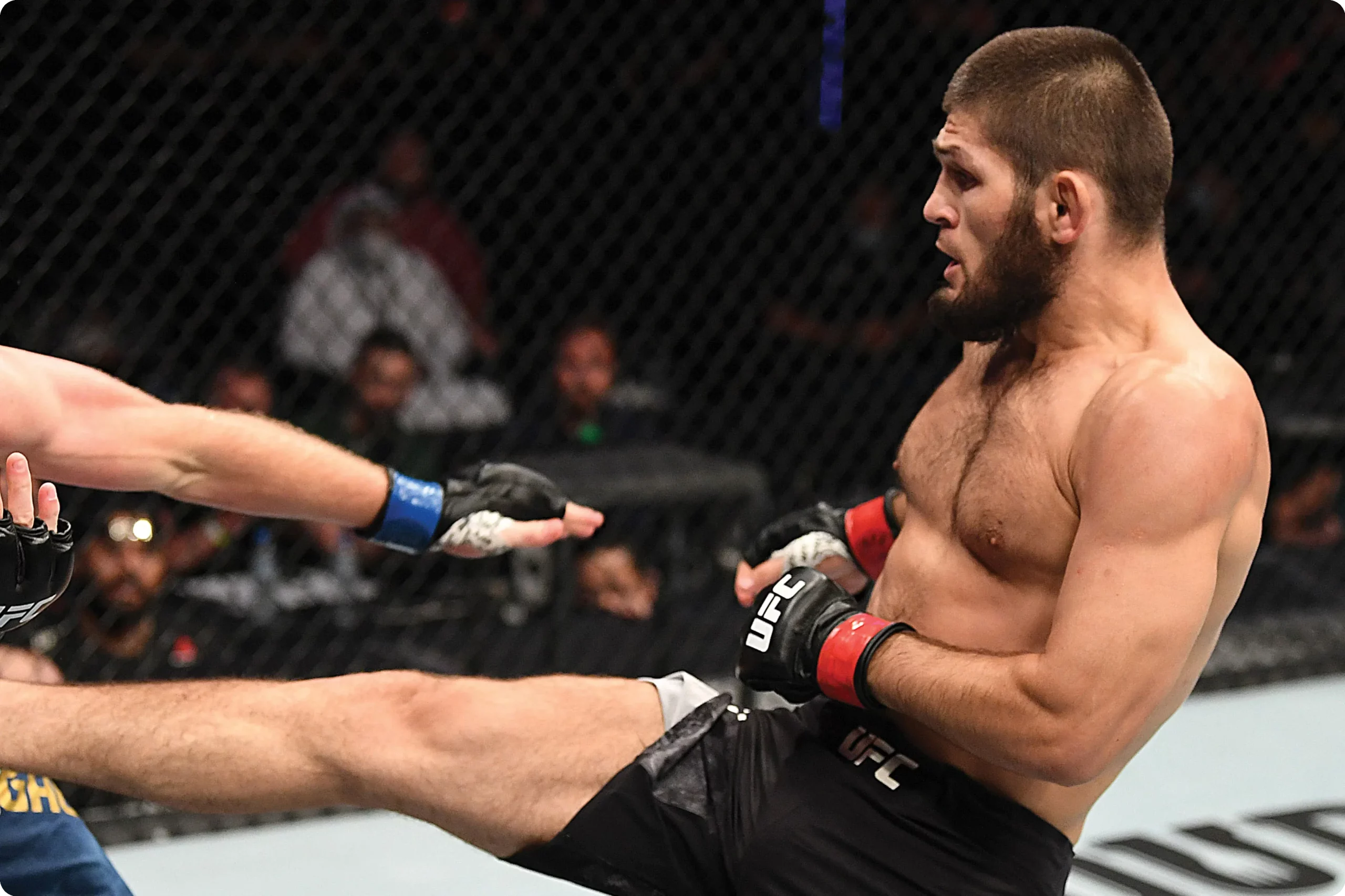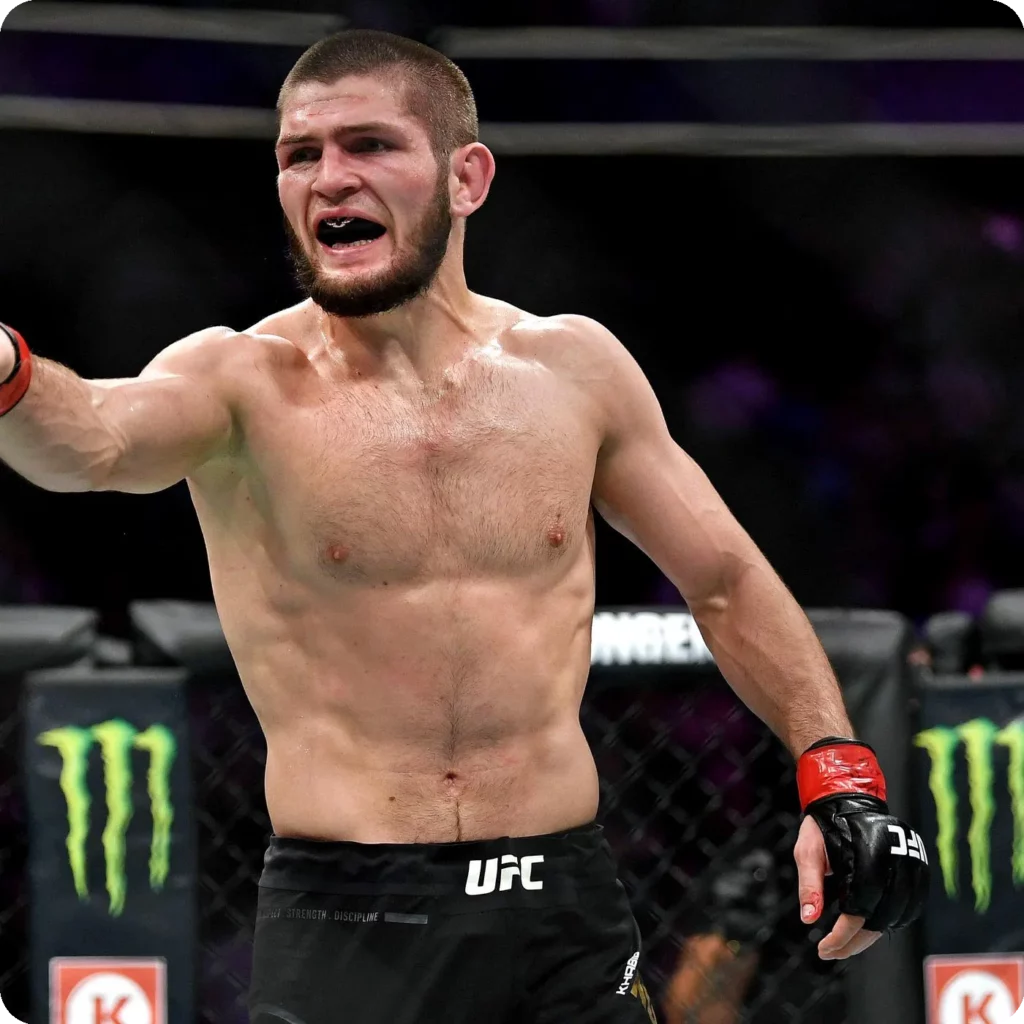Joining the UFC (2012)
UFC Debut Against Kamal Shalorus
Khabib Nurmagomedov’s first walk to a UFC Octagon came on 20 January 2012 at UFC on FX 1 in Nashville, where the 23-year-old Dagestani faced seasoned wrestler Kamal Shalorus. From the opening exchange the difference in speed and mat control was obvious: Nurmagomedov shot from far outside, chained level changes together and repeatedly forced Shalorus to defend in reverse gear. Midway through the third round he secured a deep rear-naked choke that drew the tap at 2:08, announcing his arrival with a finish and a post-fight celebration that would become iconic—the soaring leap over the fence to embrace his corner.
That debut did more than add a submission to his ledger; it positioned “The Eagle” as the most promising Russian export in UFC history. Beating a rugged veteran who had never before been submitted showed the promotion that Nurmagomedov’s sambo-judo base translated perfectly to MMA, while his 21-0 overall record hinted at a ceiling far higher than prospect status. Analysts fixated on his relentless chain-wrestling, a style that foreshadowed the dominance to come and immediately placed him on every short-list of future title contenders in the lightweight division.

Initial Impressions and Early Success
Nurmagomedov’s next four UFC appearances unfurled like chapters from a coaching manual on pressure fighting. He rag-dolled Gleison Tibau, set a still-standing record of 21 takedowns against Abel Trujillo, and shut out Pat Healy and Michael Johnson by staying glued to hips and wrists, never sacrificing position for spectacle. Each outing revealed incremental improvements—crisper boxing entries, quicker mat transitions, heavier top-pressure—yet none lasted the distance without a moment dominated by the Dagestani’s mauling ground control.
By the end of 2013 he stood at 5-0 inside the promotion with the aura of inevitability usually reserved for heavyweights in mismatches. Commentators noted that opponents seemed to lose confidence after Nurmagomedov’s first successful takedown; the grind that followed drained both gas tank and morale. Fans, too, sensed a shift: they were no longer asking whether he would become champion, only how soon. Those early years cemented his public image as a fighter who combined the suffocating grappling of a prime Matt Hughes with the competitive ruthlessness of Georges St-Pierre—an undefeated puzzle no lightweight appeared close to solving.
Dominating the Lightweight Division
Victory Over Rafael dos Anjos (2014)
The April 19, 2014 meeting with Rafael dos Anjos in Orlando was billed as a prospect-versus-contender eliminator; it ended up a one-sided lesson. Nurmagomedov stuffed the Brazilian’s early kicks, bullied him against the fence and landed repeated inside-trips that left dos Anjos looking to judges for mercy. After three rounds the scorecards read 30-27 across the board, and with them the Russian leap-frogged the rankings into bona-fide title talk. Dos Anjos would claim UFC gold less than twelve months later, underscoring how lopsided this bout had been and how far ahead Nurmagomedov already was of the division’s elite.
Tactically, the fight showcased a maturing striker unafraid to switch stances or counter with crisp hooks, but its strategic importance was greater: it proved Nurmagomedov could nullify a future champion’s strengths over fifteen minutes. The performance earned him the unofficial tag of “most avoided man at 155 pounds,” a moniker that lingered through multiple canceled bookings with Tony Ferguson and Donald Cerrone. Each withdrawal—knee injuries for Nurmagomedov, weight-cut mishaps for others—only amplified anticipation, keeping him in headlines even without stepping inside the cage.

Path to the Title and First Championship Victory
Injuries sidelined Nurmagomedov for nearly two critical years, but his return in late 2016 reminded fans nothing had changed. Wins over Darrell Horner, Edson Barboza and a brutal mauling of Michael Johnson re-established clear number-one-contender status. When the lightweight belt was left vacant by Conor McGregor’s extended layoff, UFC 223 in Brooklyn became Nurmagomedov’s coronation—even if the opponent changed repeatedly during fight week. After Tony Ferguson tore a ligament and Max Holloway failed a medical, late replacement Al Iaquinta answered the call. Five rounds later, the Russian exited with a unanimous 50-44, 50-43, 50-43 scoreline and the undisputed championship strapped around his waist.
That uneven match-up did little to dull the achievement. Nurmagomedov showcased improved jab accuracy, maintained pace unfamiliar to more flat-footed wrestlers, and secured takedowns at will when he chose. In post-fight interviews he dedicated the belt to his late father Abdulmanap, acknowledging the familial system that had forged his style deep in the Dagestani mountains. The title win completed a six-year plan mapped out in childhood and fulfilled against the chaotic backdrop of a fight week that tested his mental composure as much as his skill set.
Key Fights in UFC
Conor McGregor Fight (2018)
UFC 229 on 6 October 2018 became the highest-grossing pay-per-view in mixed-martial-arts history, driven by the combustible rivalry between Nurmagomedov and global superstar Conor McGregor. Inside the cage, however, hype surrendered to dominance. The champion absorbed McGregor’s best left in round two, answered with a thudding overhand of his own, and secured takedowns that transitioned seamlessly to wrist-rides and mounted crucifixes. Early in the fourth he trapped McGregor against the fence, passed guard, and cinched a neck crank that forced the Irishman’s submission at 3:03.
The aftermath—a now infamous leap over the cage by Nurmagomedov toward McGregor’s cornermen—sparked melee, suspensions and months of debate about sportsmanship. Yet the result left no doubt about lightweight supremacy. Media narratives of a striker-versus-grappler coin-flip dissolved; instead, analysts called it one of the most lopsided title defenses in recent memory. The bout’s commercial success plus its decisive outcome elevated Nurmagomedov from regional hero to global combat-sports figure, multiplying his social-media following and sponsorship portfolio overnight.

Defeating Dustin Poirier for the Interim Title (2019)
When Nurmagomedov returned from suspension, interim champion Dustin Poirier awaited in Abu Dhabi at UFC 242. Poirier’s boxing volume and guillotine threat were touted as potential kryptonite, but the defending champion erased both narratives with surgical control. He pressed Poirier against the fence, rode his hips like a backpack and neutralized every scramble. A single-leg entry in round three transitioned to back control and a palm-to-palm rear-naked choke; Poirier’s tap at 2:06 unified the belts and extended Nurmagomedov’s unbeaten streak to 28.
Beyond technique, the fight underlined his psychological edge: moments after escaping a tight guillotine attempt, Nurmagomedov calmly signaled thumbs-up to his corner, then rolled into a dominant position without haste. The victory in the oppressive desert heat also demonstrated his unrivaled conditioning, silencing critics who believed his relentless pace might suffer outside temperate arenas. Poirier, gracious in defeat, praised Nurmagomedov’s pressure as something he had “never felt before”—a sentiment echoed by almost every opponent on the champion’s résumé.
Khabib’s Retirement from UFC

Why Khabib Left the UFC in 2020
Just weeks after his father succumbed to COVID-19 complications, Nurmagomedov defended his title against Justin Gaethje at UFC 254 on 24 October 2020, submitting the American with a second-round triangle choke. In the Octagon he fell to his knees, wept, and stunned the MMA world by announcing immediate retirement. Later interviews revealed a private vow to his mother: she did not want him to fight without his father in his corner, and he refused to break that promise. Emotional exhaustion, an unbeaten record and financial security combined to make the decision irreversible in his eyes.
The announcement ended years of speculation about a potential move to welterweight or a rematch with McGregor. It also underscored the cultural values that had shaped his career: family loyalty outweighed legacy padding. Promoters and pundits pleaded for one more bout to reach 30-0, but Nurmagomedov’s conviction never wavered. His graceful exit at his competitive peak drew comparisons to NFL legend Jim Brown and boxer Rocky Marciano—athletes who walked away undefeated, leaving fans to ponder what-ifs rather than watch a slow decline.
UFC’s Response and Impact on the Lightweight Division
Dana White spent months in 2021 lobbying for a comeback, but on 19 March 2021 he finally conceded defeat, officially vacating the lightweight crown and booking Charles Oliveira versus Michael Chandler for the empty throne at UFC 262. The decision ended Nurmagomedov’s record 1,077-day reign and reopened a title picture that had been effectively frozen since 2018. Fighters such as Poirier, Chandler, Oliveira and Islam Makhachev suddenly saw a clear route to gold, triggering one of the most competitive eras the division has seen.
In retrospect, Nurmagomedov’s departure reshaped matchmaking logic: grappling-heavy contenders were no longer viewed as stylistic dead ends, and the Dagestani training system—elevated by his success—became the blueprint for a new generation. Sponsorship dollars and media focus that once orbited the champion redistributed across fresh faces, accelerating the rise of Oliveira and later Makhachev. The lightweight belt changed hands twice within a year, proof that parity had replaced previous hegemony. Even in absence, “The Eagle” dictated the narrative arc of the division he once owned.
Khabib’s UFC Record
Undefeated Streak and Career Stats
Nurmagomedov closed the book on his professional career at a pristine 29-0, including a 13-0 slate in the UFC. He finished 19 opponents—eight by knockout, 11 by submission—and absorbed fewer than two significant strikes per minute, among the stingiest defensive metrics recorded in the promotion’s modern stats era. Across 60 completed rounds he is widely believed to have lost only one on judges’ cards, round three against McGregor, underscoring the breadth of his dominance.
His takedown accuracy (48 percent) and control time stood out, but it was the attritional damage inflicted while maintaining positional safety that separated him from pure wrestlers. Importantly, he never fought at catch-weight or missed weight once the UFC introduced stricter early-morning weigh-ins, reinforcing a professional consistency rare at the elite level. Those numbers form a statistical monument as imposing as the highlight-reel suplexes and submissions that thrilled crowds.

Records and Achievements in the UFC
Nurmagomedov holds—or shares—multiple UFC records: longest lightweight title reign (1,077 days); most title defenses in the division’s modern era (three, tied with B.J. Penn, Benson Henderson and Frankie Edgar); and first Russian champion in the promotion’s history. Pay-per-view buys for UFC 229 surpassed 2.4 million, a benchmark still unbroken, reflecting his drawing power. Beyond numbers, he was inducted into the UFC Hall of Fame’s “Modern Wing” in 2022, symbolizing his impact on the sport’s strategic evolution toward dominant positional grappling.
Perhaps the most telling accolade is qualitative: peers routinely describe preparing for Nurmagomedov as shaping an entire training camp around cage-wrestling defense, only to discover it remains futile on fight night. That combination of predictability and inevitability is the essence of his legend. When he left, fans felt the absence of a champion whose fights carried an almost ritual certainty: the moment he clasped his hands behind an opponent’s knees, the outcome felt pre-ordained. Records capture the victories; myth captures the aura—and both, for now, remain unblemished.